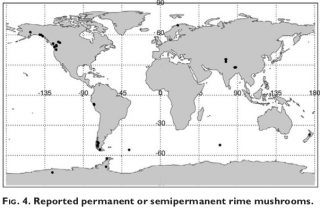Mountain climber Dmitry Golovchenko captured tremendous video of the February 27 collapse of a “rime mushroom” atop Patagonia’s Cerro Torre. These are bulbs of massively accumulated rime—built up in the freezing of moisture in winds pounding at the peak over time. The mushrooms increase the difficulty of this infamous climb of more than 3,000 meters, but never more so than when their precariousness increases in summer—just when conditions might otherwise seem calm enough for climbing. Here is the video via an Instagram from patagoniavertical, the site of Rolando Garibotti, who co-authored a BAMS article on these infamous mushroom features:
In their BAMS article, David Whiteman and Garibotti introduced rime mushrooms, well known to alpinists, but not previously to many meteorologists:
Rime mushrooms, commonly called ice mushrooms, build up on the upwind side of mountain summits and ridges and on windward rock faces. These large, persistent, rounded or bulbous accretions of hard rime range from pronounced mounds to towering projections with overhanging sides….[They] form when clouds and strong winds engulf the terrain. Supercooled cloud droplets are blown onto subfreezing surfaces and freeze rapidly, making an opaque “hard” rime with air trapped between granular deposits. The mushrooms are most frequent and best developed on isolated summits and exposed ridges in stormy coastal areas.
They showed the distribution of these mountain features around the world.
 Thanks to Dr. Whiteman’s Univ. of Utah colleague Jim Steenburgh for bringing the video to our attention via social media. Jim’s own newly published BAMS article features the often well-rimed sea-effect snows of Japan and their similarities to lake-effect snows in the United States. The article explains how the heavy snowy accumulations of crunchy graupel (loose, rimed, large icy particles) in lowlands of the Japanese coast can be quite avalanche prone, too.
Thanks to Dr. Whiteman’s Univ. of Utah colleague Jim Steenburgh for bringing the video to our attention via social media. Jim’s own newly published BAMS article features the often well-rimed sea-effect snows of Japan and their similarities to lake-effect snows in the United States. The article explains how the heavy snowy accumulations of crunchy graupel (loose, rimed, large icy particles) in lowlands of the Japanese coast can be quite avalanche prone, too.